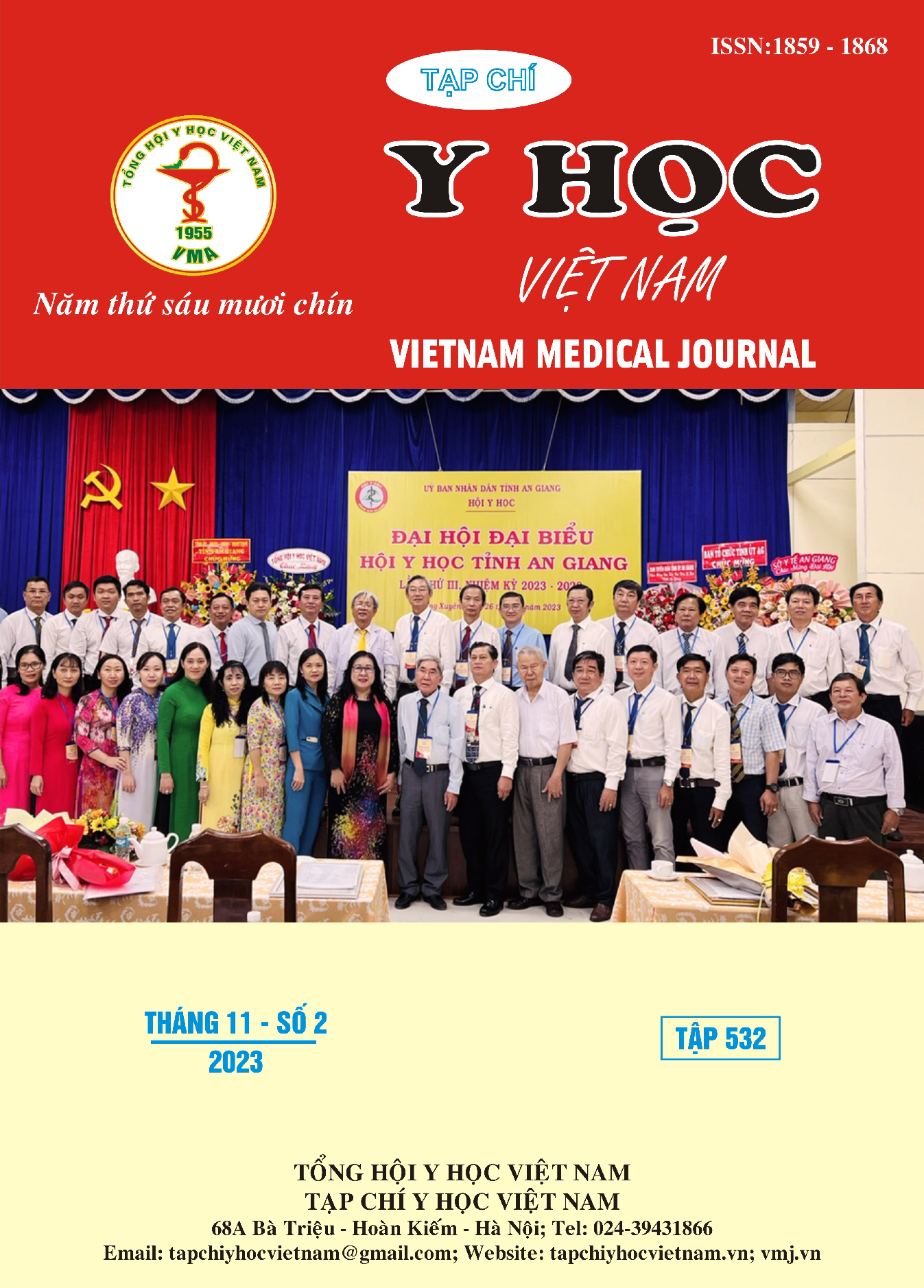CLINICAL AND ULTRASOUND CHARACTERISTICS OF NAIL LESIONS IN PATIENTS WITH PSORIATIC ARTHRITIS
Main Article Content
Abstract
Objectives: Description of clinical and ultrasound nail lesions in patients with psoriatic arthritis. Subjects and methods: A cross-sectional descriptive study on 300 nails in 30 patients with psoriatic arthritis at the Rheumatology Departement of Bach Mai Hospital from November 2022 to July 2023. The patient was diagnosed with psoriatic arthritis using CASPAR 2006 criteria, assessing the disease activity level using DAPSA scale. The clinical nail lesions were evaluated in nail matrix (pitting, leukonychia, red spotted lunula and nail plate crumbling) and nail bed (subungual hyperkeratosis, onycholysis, oil spots and splinter hemorrhages). The ultrasound nail parameters evaluated are nail plate thickness, nail bed thickness, type of Wortsman nail, Doppler signal in nail bed and nail matrix. Results: The clinical nail lesions are presented in 21/30 patients (70%) with 179/300 nails (59.7%). The most common clinical nail lesions are onycholysis (63.1%) and pitting (50.3%). 250/300 nails (83.3%) had ultrasound nail lesions in 30/30 patientes (100%). The average nail plate and nail bed thickness are 0.67 ± 0.23mm and 1.62 ± 0.33mm, respectively. Nails were divided into two groups according to the presence or absence of clinical nail lesions. The average nail plate thickness on ultrasound of the nails with clinical lesions (0.74 ± 0.27 mm) is higher than that of the nails without clinical lesions (0,58 ± 0,11 mm) statistically significant (p<0.05). The average nail bed thickness on ultrasound of the nails with clinical lesions (1.70 ± 0.36 mm) is higher than that of nails without clinical lesions (1.53 ± 0.27 mm) statistically significant (p<0.05). The most common type of ultrasound nail is Wortsman II (48.8%). The most common of the maximum Doppler signals of the nail matrix and the nail bed is 3 with the rate of 174/300 nails (58.0%) and 161/300 nails (53.7%), respectively. Conclusion: The clinical nail lesions are presented in 70% patients while the ultrasound nail lesions are appeared in 100% patients. Onycholysis (63.1%) and pitting (50.3%) were detected in our patients with psoriatic arthritis as the most common clinical types of nail lesions. Nail ultrasound is a noninvasive technique that allows evaluation of each part of the nail unit and the Doppler signal. The most common type of ultrasound nail is Wortsman II (48.8%).
Article Details
Keywords
psoriatic arthritis, nail psoriasis, nail ultrasound.
References
2. Krajewska-Włodarczyk M, Owczarczyk-Saczonek A, Placek W, Wojtkiewicz M, Wiktorowicz A, Wojtkiewicz J. Ultrasound assessment of changes in nails in psoriasis and psoriatic arthritis. BioMed research international. 2018;2018
3. Idolazzi L, Gisondi P, Fassio A, et al. Ultrasonography of the nail unit reveals quantitative and qualitative alterations in patients with psoriasis and psoriatic arthritis. Medical Ultrasonography. 2018;20(2):177-184.
4. Naredo E, Janta I, Baniandrés-Rodríguez O, et al. To what extend is nail ultrasound discriminative between psoriasis, psoriatic arthritis and healthy subjects? Rheumatology International. 2019;39:697-705.
5. Cù Huy Nghĩa, Trần Thị Tô Châu. Nghiên cứu đặc điểm hình ảnh siêu âm gân achille ở bệnh nhân viêm khớp vảy nến. Luận án thạc sĩ y học. Trường Đại học Y Hà Nội; 2020.
6. Cengiz G, Nas K, Keskin Y, et al. The impact of nail psoriasis on disease activity, quality of life, and clinical variables in patients with psoriatic arthritis: A cross‐sectional multicenter study. International Journal of Rheumatic Diseases. 2023;26(1):43-50.
7. Bellinato F, Gisondi P, Filippucci E, et al. Systematic study on nail plate assessment: differences in nail plate shape, thickness, power Doppler signal and scanning approach. Archives of Dermatological Research. 2023;315(3):593-600.
8. Agache M, Popescu CC, Enache L, Dumitrescu BM, Codreanu C. Nail Ultrasound in Psoriasis and Psoriatic Arthritis—A Narrative Review. Diagnostics. 2023;13(13):2236.


